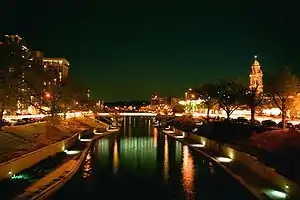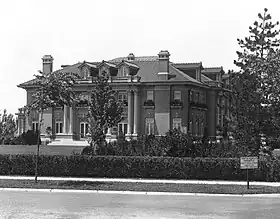 Ward Parkway, split by Brush Creek in the Country Club Plaza near its eastern terminus | |
| Namesake | Hugh Campbell Ward, son of Seth E. Ward |
|---|---|
| Type | boulevard |
| Length | 6.8 mi (10.9 km) |
| Coordinates | 39°0′0.2″N 94°36′11.9″W / 39.000056°N 94.603306°W |
| North | Brookside Boulevard / Volker Boulevard |
| South | Wornall Road |
| Other | |
| Known for | High-class neighboorhoods, redlining, fountains |
| Ward Parkway | |
|---|---|
| Type | Boulevard median greenspace |
| Location | Kansas City, Missouri, United States |
| Coordinates | 39°01′56″N 94°36′20″W / 39.032181°N 94.605669°W |
| Area | 211.14 acres (0.8545 km2; 0.32991 sq mi) |
| Designer | J.C. Nichols |
| Owned by | City of Kansas City, Missouri |
| Website | kcparks.org |
Ward Parkway is a boulevard in Kansas City, Missouri, United States. Ward Parkway begins at Brookside Boulevard on the eastern edge of the Country Club Plaza and travels west 2.8 miles along Brush Creek as U.S. Route 56 before turning south near Kansas-Missouri state line. It continues south for 4 miles, terminating at Wornall Road near Bannister Road. A short spur, Brush Creek Parkway, connects Ward Parkway to Shawnee Mission Parkway at State Line Road.

The street is named after the family of local businessman and real estate tycoon Seth E. Ward (1820-1903), who owned property on both sides of the parkway. His family's mansion is located at 1032 West 55th Street along Ward Parkway and remains on the National Register of Historic Places.[1]
Ward Parkway has a wide, landscaped median, which is decorated with fountains and statuary. Many of Kansas City's finest large houses are along Ward Parkway as part of the planned Country Club District.
Location
- Northern terminus: Brookside Blvd./Volker Blvd. 39°02′22″N 94°35′07″W / 39.03932°N 94.58529°W
- Southern terminus: Wornall Road 38°57′33″N 94°35′44″W / 38.95918°N 94.59568°W
History
Ward Parkway was created as part of developer J.C. Nichols's overall plans for the Country Club District. Desiring a boulevard that would exceed the aesthetic value of all other streets in Kansas City, Nichols hired landscape architect George Kessler, who had designed several other boulevards, parks, and neighborhoods throughout Kansas City, Missouri, including Hyde Park.[2] The street was named after prominent Kansas City attorney Hugh Campbell Ward (1864-1909), a business partner of J.C. Nichols who donated his family property to the city.[3] Though he died before the papers were signed, his wife, Vassie James Ward, followed his will.[3][4]
As Nichols platted the district, beginning in 1906, he reserved space for Ward Parkway. The largest lots in the district were reserved for houses to be built along the boulevard. The Kansas City Parks Department added Ward Parkway into its formal boulevard system. Nichols traveled to Italy and England to buy statues and monuments to place in the boulevard's wide median. He also placed ponds and decorative urns throughout the parkway's length. To promote his development, Nichols periodically placed photographs of the large houses being built along Ward Parkway in Sunday editions of the Kansas City Star. Nichols even moved into a house on this new development.[5]
Shortly following establishment of the U.S. Highway System, U.S. Route 50 was drawn concurrent to the section of Ward Parkway between Southwest Trafficway and State Line Road.[6] Following many years of discussion, U.S. Route 56 additionally serviced this section of Ward Parkway beginning in 1957, with U.S. Route 50 being moved concurrent with Interstate 435 and Interstate 470 following the latter's completion in 1979.[7][8][9] This half-mile section of Ward Parkway is maintained as U.S. Route 56 to the present day.
Some of the most prominent Kansas City families chose to build their homes on Ward Parkway (notable examples include Tom Pendergast House, Bernard Corrigan House, and Mack B. Nelson House).[3] By the time Evan S. Connell wrote Mrs. Bridge in 1959, the proximity of a prominent Kansas Citian's house to Ward Parkway was seen as an indication of that person's place in Kansas City society. Continuing to today, the perceived social capital associated with living in proximity to Ward Parkway has made it home to a disproportionate number of Kansas City's wealthiest, most educated, and healthiest residents.[10]>
In 2012, Ward Parkway was named a Great Street in the American Planning Association's annual list of Great Places in America, citing that the passion “by both citizens and city government to maintain the parkway has allowed it to remain one of the area's most coveted addresses with historic homes, neighborhood parks, picturesque fountains, ornamental monuments, and rolling landscapes.”[11]
Improvement and Preservation
The Ward Parkway Center Community Improvement District, the area contained by W 85th Terrace, Ward Parkway, W 89th Street, and State Line Road, was created in 2011 to allow the city to levy a one percent sales tax to help fund parkway projects and redevelop the area.[12] One project that benefited from the District is the Ward Parkway Center, a large indoor shopping center near the southern end of the parkway.[13] In addition, the city allocated more than $9 million for the maintenance and improvements of park grounds, fountains and monuments, and recreational facilities along parkways.[12]
Several sites and buildings along Ward Parkway are designated as National Historic Sites and are listed on the National Register of Historic Places. These include the Park Manor Historic District at 910-920 Ward Parkway; the Serena Apartment Hotel, a nine-story Italian Renaissance Revival Villa, and the Alexander Majors Antebellum house at West 83rd. In 1996, design guidelines for building along the parkway were adopted, and new construction on the parkway requires a certificate from the Historic Preservation Committee.[12]
Points of interest
- Kansas City Public Library Plaza Branch, located at 4801 Main Street near the intersection of Ward Parkway and Brookside Boulevard
- Country Club Plaza shopping center, located to the north of Ward Parkway between Baltimore Avenue and Roanoke Parkway
- InterContinental Kansas City at the Plaza, located at 401 Ward Parkway
- The Pembroke Hill School Ward Parkway Campus, located at 5121 State Line Road along Ward Parkway
- The Carriage Club, located along Ward Parkway between Brush Creek Boulevard/Shawnee Mission Parkway and 55th Street.
- Mirror Pool Fountain, located within the Ward Parkway median between W 61st Terrace and W 62nd Street.
- The Meyer Circle Sea Horse Fountain, featuring a 17-century Venetian sculpture, located at the intersection of Ward Parkway and Meyer Boulevard[14]
- Alexander Majors Historic Museum and Barn, a building on the National Register of Historic Places, located at 8145 State Line Road at Ward Parkway and West 83rd Street.[15]
- Ward Parkway Center, located at 8600 Ward Parkway
- Burns & McDonnell, an architecture and engineering firm, is headquartered at 9450 Ward Parkway
Notable residents of houses along Ward Parkway

- Tom Pendergast, political boss
- Keith A. Tucker, former CEO of Waddell & Reed mutual fund company
- Peter Brown, CEO and Co-founder of AMC Theatres.
- Jason Kander, politician
- Richard Bloch, co-founder of H&R Block
See also
References
- ↑ Perry, Zack (January 16, 2017). "Taste & See KC: The history behind Ward Parkway". KSHB 41 Kansas City. Retrieved August 8, 2023.
- ↑ Mumford, Eric (2018). Designing the Modern City: Urbanism Since 1850. Yale University Press. p. 117. ISBN 978-0-300-20772-9.
- 1 2 3 Van Luchene, Katie (2010). Insiders' Guide to Kansas City. Rowman & Littlefield. p. 121. ISBN 978-0-7627-5343-7.
- ↑ Christensen, Lawrence O.; Foley, William E.; Kremer, Gary, eds. (1999). Dictionary of Missouri Biography. University of Missouri Press. p. 575. ISBN 0-8262-1222-0.
- ↑ "Home of J.C. Nichols at 1214 Santa Fe Road". The Pendergast Years: Kansas City in the Jazz Age and Great Depression. The Kansas City Public Library. November 30, 2017. Retrieved August 8, 2023.
- ↑ Missouri State Highway Commission (1928). Official Road Map of Missouri 1928 (PDF) (Map). Missouri Highway Map. Jefferson City, MO. Kansas City inset. Retrieved August 13, 2023.
- ↑ Oklahoma Department of Transportation, Chronological History Documentation: US 56 Archived 2016-03-03 at the Wayback Machine (correspondence between ODOT, AASHO, and other DOTs)
- ↑ Missouri State Highway Commission (1957). Map of the Missouri State Highway System (PDF) (Map). Missouri Highway Map. Cartography by MO Division of Highway Planning and US Bureau of Public Roads. Jefferson City, MO. Kansas City - Independence Area inset. Retrieved August 13, 2023.
- ↑ Missouri State Highway Commission (1980). Missouri 1980 Official Highway Map (PDF) (Map). Missouri Highway Map. Jefferson City, MO. Kansas City inset. Retrieved August 13, 2023.
- ↑ Greenberg, Michael R (January 28, 2021). "Measuring Historical Urban Neighborhood Sustainability: America's Grand Avenues". Sustainability. 13 (3): 1358. doi:10.3390/su13031358.
- ↑ "Ward Parkway: Kansas City, Missouri". American Planning Association. Retrieved October 12, 2019.
- 1 2 3 "Archived copy". Archived from the original on October 21, 2020. Retrieved February 9, 2013.
{{cite web}}: CS1 maint: archived copy as title (link) - ↑ "Kansas City's Ward Parkway Center applies for Community Improvement District to finance updates". Kansas City Business Journal. March 11, 2011. Retrieved October 9, 2014.
- ↑ "Meyer Circle Sea Horse Fountain". KC Parks and Rec. Retrieved August 8, 2023.
- ↑ "Alexander Majors House". Library of Congress. Retrieved August 8, 2023.